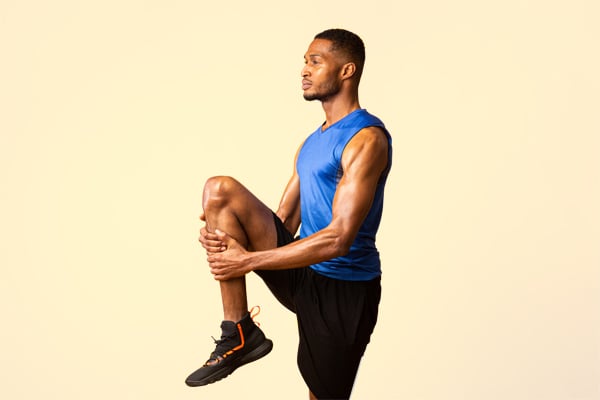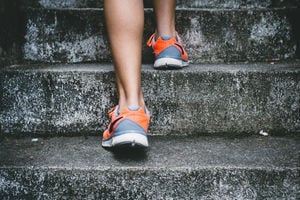
Always start off slow, and be sure to test the abilities of your injured body part carefully. PHOTO/www.shutterstock.com
In the pursuit of a healthy and active lifestyle, individuals with bad or injured knees often face the challenge of finding suitable workouts that will not exacerbate their condition. The good news is, maintaining fitness is possible with the right exercises that prioritise joint health.
Shergil Mugerwa, a fitness coach at Andex Fitness Centre in Kiwatule, Kampala, says the knee is the largest joint in the body, making it susceptible to a variety of injuries. Knee injuries are not exclusive to athletes; they can happen to anyone. The injury might result from a fracture, dislocation, sprain, or tear of soft tissues inside the ligaments.
While it may seem counterintuitive to exercise knees when in pain, practicing aerobic (cardio) and weight-bearing exercises is essential for relieving knee pain and preventing future issues. Symptoms of an injured knee may include knee pain, visible swelling around the knee area, and weak knees, hindering effective workouts. Mugerwa notes that people who are overweight are also likely to have weak knees.
Exercises for weak knees
Mugerwa advises consulting a physician for individuals with injuries to determine suitable exercises and those to avoid. When at the gym, speak to a fitness instructor for personalised guidance.
Start with a warm-up before working out, focusing more on the upper body depending on the severity of the injury. Mugerwa recommends simple, low-impact workouts, preferably using body weight only, without additional weights, until the injury heals. Variations of a full-body workout are possible without squats; if opting for squats, consider quarter squats or squats with resistance. Include deadlifts, shoulder presses, heel touches, and walking lunges in your routine.
According to healthline.com, cardiovascular exercises are crucial for heart health, but for those with knee concerns, choosing low-impact alternatives is key. Avoid the treadmill; instead, consider cycling, an overall workout providing aerobic and strengthening benefits without excessive pressure on knee joints. Water exercises, such as swimming, jogging in water, and water aerobics, are recommended by Mugerwa. They help strengthen knee muscles, leveraging water buoyancy to exercise with minimal joint pressure.
Walking is also an effective workout that not only burns calories and aids in weight loss but also lubricates joints. It increases blood flow to tight muscles and strengthens the muscles surrounding the knee.
Building muscle around the knees is crucial for stability and support. Incorporate strength training exercises targeting key muscle groups, such as leg presses with a leg press machine. Strengthen the quadriceps and hamstrings with controlled movements on the leg press machine, minimizing stress on the knees.
Prioritise flexibility exercises to prevent stiffness and reduce the risk of injury. Include stretches in your workout routine, seeking guidance from your fitness instructor on appropriate stretches.
Note
Experiencing mild knee pain or discomfort after a workout is common, but if the pain is intense and persists, there could be a problem. Knee pain is a common exercise complaint, affecting about 25 percent of adults, Mugerwa explains. There are several potential causes, including ligament tears, osteoarthritis, bursitis, and runner's knee. The course of treatment will depend on your diagnosis.
“The knee is a complex joint involving bones, ligaments, menisci, muscles, and tendons that all support the joint. You may have achy knees if there is damage or stress to any of those components. Many physical activities, such as bending, jumping, running, and stretching, can impact or strain your knees, which may cause pain while you work out,” says Mugerwa.
Bursitis
Bursitis, Mugerwa says, causes pain in the front of your knee if a bursa becomes irritated and swollen. A bursa is a fluid-filled sac that cushions and protects your bones, muscles, and tendons. Inflammation may occur due to injury, overuse of the knee, or repeated pressure against the knee, such as kneeling. Changes in activity level can also cause inflammation, for example, training for a marathon, which may involve one doing more intense exercises than they normally do. Infections and some types of arthritis may cause bursitis.
Bursitis symptoms include pain and tenderness when you press against your knee, pain around your knee, pain while moving and resting, plus redness, swelling, or warmth around the knee, and stiffness while moving.
Ligament tear
Ligaments are tissues that connect bones. The anterior cruciate ligament (ACL) and medial collateral ligament (MCL) can tear and cause instability, pain, and swelling.
"The ACL runs in the middle of your knees. The MCL, located in the inner knees, prevents them from bending inward. The ACL and MCL are the two most commonly injured ligaments of the knee, although you can also tear your posterior cruciate ligament (PCL) and lateral collateral ligament (LCL) as well,” he says.
Runner's knee
Runner's knee, or patellofemoral pain syndrome (PFPS), is an overuse injury affecting the knee joint. It affects people who engage in running activities. Runner's knee often causes a painful grating sensation. The pain, according to Mugerwa, is likely to increase when climbing up the stairs, standing up from a chair, while running, squatting, or after sitting for long periods.
According to the fitness coach, Runner's knee is one of the most common overuse injuries, affecting about 13 pecent to 30 percent of runners. People often develop runner's knee when they change their running mileage or speed or start doing more hill training than usual. Others may develop runner's knee after surgery or trauma to the knee. Poor nutrition, sleep, and stress may also contribute to the injury.
“People generally recover from runner's knee, but it usually takes a while. About 40 percent of people still show symptoms after one year of treatment. To treat runner’s knee, you can exercise your hip and knee, put some icing on your knee, modify your workouts, and tap your knee. You can also use nonsteroidal anti-inflammatory (NSAID) drugs, prescribed by a professional medical personnel, to relieve pain.”




